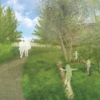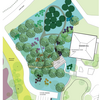The award-winning Sustainable Wetland Garden, located near Widener Hall and Cottage Hall, is a working demonstration of sustainable principles and management. Sustainable elements include recycled-glass pavers, a biological filtration feature, and native plant communities.
Subtle topographical variations within the Wetland Garden landscape provide an opportunity to study, explore and enjoy plant responses to ever-fluctuating levels of inundation from rainwater and runoff. Enhancements to the existing topography such as the creation of depressions, stepped pools and check dams can provide an opportunity to capture additional rainwater and demonstrate an artful approach to best management practices.
The design of this space will seek to provide a model of an impressionistic wetland. The wetland will begin with thresholds organized by groupings of trees that allow visitors to peer inside to see a generous, sinuous green pathway.
Large plantings of Bald Cypress will flank the Northern entry. On the upland edges, selections of Highbush Blueberry will be grouped to provide opportunities for student evaluation, species comparison, and cross pollination, as well as providing a local food source. The Southwest entry will be flanked with a more simplified palette of woody plants.
The Wetland’s core, with additions of Red Maple, Black Willow, Swamp White Oak, Alders, and Black Gum trees, will be planted to reestablish the woodland fractured by Hurricane Ida. The ground will be covered in bold, stylized drifts of highly competitive plants, such as pink turtlehead (Chelone lyonii), Palm Sedge (Carex muskingumensis), Northern Sea Oats (Chasmanthium latifolium), and Blue Flag and Copper Iris (Iris versicolor and Iris fulva).


